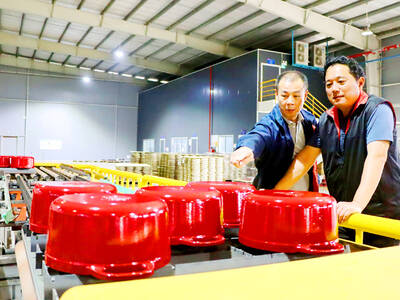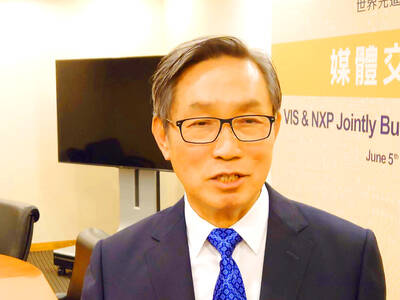They call it “the shrink” — it is the challenge of how to pack more circuits onto the microchips that power everything from our smartphones to our computers, even our coffee machines.
Pushing the boundaries of this technology is Dutch company ASML Holding NV, which since its foundation in 1984 has quietly become a world leader in the semiconductor business.
“There is more power in your smartphone today than was used to put man on the moon,” said ASML chief operating officer Frederic Schneider-Maunoury, animatedly waving his mobile phone in the air.
When you open an app on your smartphone, the chain allowing you to book a flight, message a friend or check out who is hot in your neighborhood most likely arcs all the way back to ASML.
Headquartered in Veldhoven, near the Belgian border, it builds sophisticated lithography machines to enable the world’s top chipmakers — Intel Corp, Samsung Electronics Co and Apple Inc supplier Taiwan Semiconductor Manufacturing Co (台積電) — to produce the smallest, most powerful and most cost-effective microprocessors on the planet.
Its newest machines use highly focused extreme ultra-violet (EUV) light to imprint designs on the chips, and are at the cutting edge of what is technologically possible in the art of miniaturization.
Last year, after two decades of research and development and billions of euros, ASML shipped its first 12 EUV machines to clients. Each costs about 120 million euros (US$143.53 million). This year, it has projected sales of 20 machines — by 2020, it hopes to be selling 35 to 40 a year.
It is ironic that these machines, which produce chips of infinitesimally small dimensions, are the size of a bus. Three Boeing 747 aircraft are needed to transport one machine to a client.
Long seen as a bellwether of the tech industry, the company is listed on the Amsterdam bourse, the AEX and the NASDAQ in New York.
Last year it announced profits had almost doubled to 2.12 billion euros on record sales of 9.05 billion euros.
Only two other companies in the world — the Japanese giants Nikon Corp and Canon Corp — make lithography machines and neither has yet developed EUV technology.
“Our problem is not just to find the technologies, we have to put it into the products in an economical way,” Schneider-Maunoury told reporters at his office.
ASML now employs about 20,000 people, mostly engineers and most in Veldhoven, but it also has sites in Asia and the US.
As it grows, it is hiring. About 3,000 new posts were added last year, with a similar number of new jobs expected this year.

STEEP DECLINE: Yesterday’s drop was the third-steepest in its history, the steepest being Monday’s drop in the wake of the tariff announcement on Wednesday last week Taiwanese stocks continued their heavy sell-off yesterday, as concerns over US tariffs and unwinding of leveraged bets weighed on the market. The benchmark TAIEX plunged 1,068.19 points, or 5.79 percent, to 17,391.76, notching the biggest drop among Asian peers as it hit a 15-month low. The decline came even after the government on late Tuesday authorized the NT$500 billion (US$15.2 billion) National Stabilization Fund (國安基金) to step in to buoy the market amid investors’ worries over tariffs imposed by US President Donald Trump. Yesterday’s decline was the third-steepest in its history, trailing only the declines of 2,065.87 points on Monday and

TAKING STOCK: A Taiwanese cookware firm in Vietnam urged customers to assess inventory or place orders early so shipments can reach the US while tariffs are paused Taiwanese businesses in Vietnam are exploring alternatives after the White House imposed a 46 percent import duty on Vietnamese goods, following US President Donald Trump’s announcement of “reciprocal” tariffs on the US’ trading partners. Lo Shih-liang (羅世良), chairman of Brico Industry Co (裕茂工業), a Taiwanese company that manufactures cast iron cookware and stove components in Vietnam, said that more than 40 percent of his business was tied to the US market, describing the constant US policy shifts as an emotional roller coaster. “I work during the day and stay up all night watching the news. I’ve been following US news until 3am

Six years ago, LVMH’s billionaire CEO Bernard Arnault and US President Donald Trump cut the blue ribbon on a factory in rural Texas that would make designer handbags for Louis Vuitton, one of the world’s best-known luxury brands. However, since the high-profile opening, the factory has faced a host of problems limiting production, 11 former Louis Vuitton employees said. The site has consistently ranked among the worst-performing for Louis Vuitton globally, “significantly” underperforming other facilities, said three former Louis Vuitton workers and a senior industry source, who cited internal rankings shared with staff. The plant’s problems — which have not

TARIFF CONCERNS: The chipmaker cited global uncertainty from US tariffs and a weakening economic outlook, but said its Singapore expansion remains on track Vanguard International Semiconductor Corp (世界先進), a foundry service provider specializing in producing power management and display driver chips, yesterday withdrew its full-year revenue projection of moderate growth for this year, as escalating US tariff tensions raised uncertainty and concern about a potential economic recession. The Hsinchu-based chipmaker in February said revenues this year would grow mildly from last year based on improving supply chain inventory levels and market demand. At the time, it also anticipated gradual quarter revenue growth. However, the US’ sweeping tariff policy has upended the industry’s supply chains and weakened economic prospects for the world economy, it said. “Now